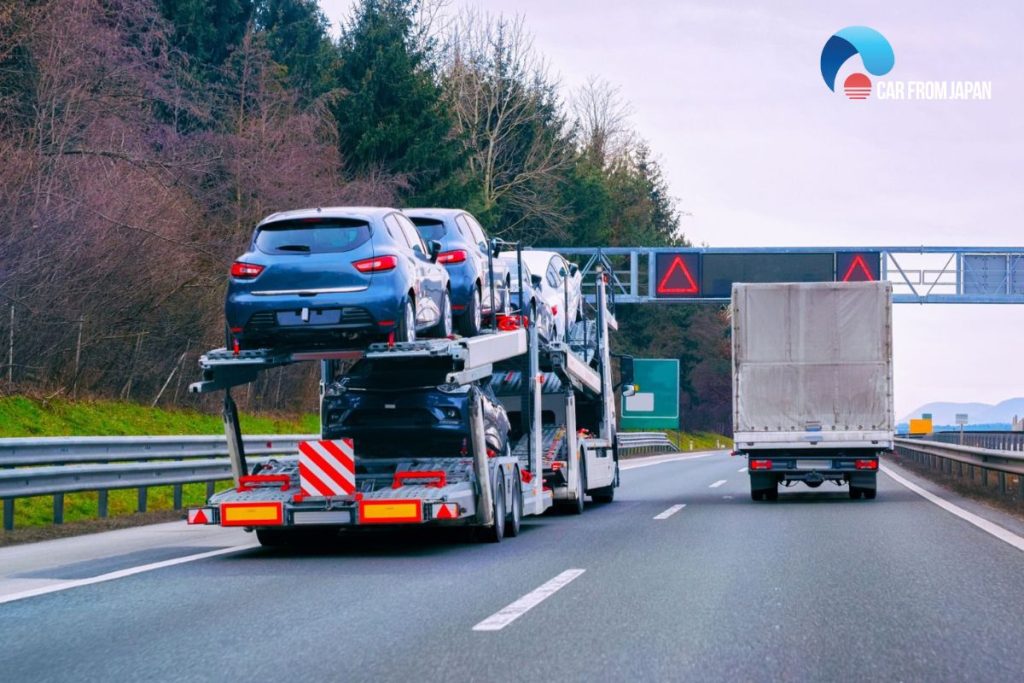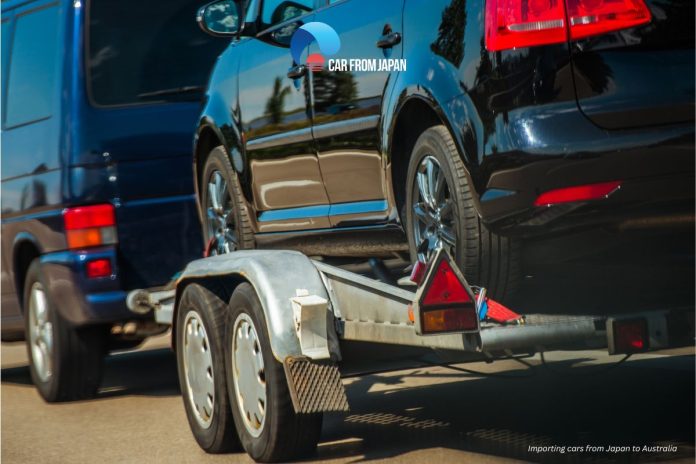Importing cars from Japan to Australia can be a smart choice. Because of Japan’s strict regulations, these vehicles are well-maintained, and some units come with a very low-mileage. Also, Japanese owners often upgrade their cars, leaving them in a pristine condition.
And if you’re a motorhead, you can use this opportunity to own a rare JDM (Japanese Domestic Market). How cool will it be to have a Toyota Land Cruiser or Nissan Skyline in your garage?
We’ll discuss all the details of how to import a car from Japan to Australia. You’ll get a clear idea of the whole process, the required documents, and estimated expenses.
Contents
Can I Import and Register a Car from Japan to Australia?
Yes, you can absolutely import and register a car from Japan to Australia. However, you have to be aware of some regulations and follow some rules to do that.
The Rules of Import
You can import a vehicle if it meets certain criteria: listed on the Specialist Enthusiast Vehicle Scheme (SEVS) register, be over 25 years old, or owning the car in a foreign country for more than a year.
The 25-Year Rule
Vehicles that are over 25 years old qualify for the Historic Vehicle Scheme, making them easier to import. It means you can bring in those classic cars that might not be readily available in Australia. However, remember that not all old vehicles fit this category.
Specialist Enthusiast Vehicle Scheme (SEVS)
So, what’s this SEVS all about? Essentially, it allows you to import specific models that meet Australian standards. But there’s a catch: your car needs to have an approved model report that outlines how your vehicle can comply with local regulations.
Even if your car is on the SEVS register, it can’t be imported unless there’s a model report for it. You can find lists of eligible models and those with approved reports on the ROVER website.
Personal Import
If you’ve owned a car overseas for more than a year, you might qualify for a personal import. However, you must provide proof of ownership and a license to drive it in Australia. Also, don’t forget to submit your application within six months of arriving in Australia.
The Rules of Registration
You can register your car after it’s shipped to Australia and passed all the compliance checks. When all the paperwork is done and all the fees are paid, you can proceed to register your car with the relevant State or Territory authority.
Pros and Cons of Importing Cars from Japan
Importing vehicles from Japan offers some unique advantages that you won’t find when importing from other countries.
However, there are some downsides too that you should consider. We’ve discussed them in detail for your better understanding.
Pros
Exceptional Quality: Japanese vehicles are famous for their outstanding quality. Brands like Toyota, Honda, and Nissan have a reputation for manufacturing high-quality cars.
Unique Selections: Japan has a selection of vehicles that are hard to find in Australia. Typical Australian models can’t match the compact kei cars, classic variants, and modern hybrids found in Japan.
Cost-Effective Choices: You can often find premium used cars at prices lower than similar models available in Australia. For example, buying a JDM sports car, like a Nissan Silvia, can be more affordable than purchasing a comparable model here.
High Resale Value: Most Japanese cars, especially the JDM models, hold their value well because of their rarity and demand among car lovers. If you decide to sell yours in the future, you’re likely to get a good price.

Cons
Compliance Hurdles: Australian Design Rules (ADR) set strict standards for vehicles on the road. So, a car from Japan may need modifications to be roadworthy. The ADR could ask you to adjust the headlights or install child seat anchors.
Hidden Costs: Importing a car involves paying more than just the purchase price. Shipping fees, taxes, and other charges can surprise you if you’re not prepared.
Availability of Parts: It could be harder to find parts for some Japanese models in Australia. So, repairs may take a longer time and cost more.
Insurance Considerations: Insurance providers may ask for higher premiums for imported vehicles. They may consider these vehicles riskier because of their age and rarity in Australia.
How to Import a Car from Japan to Australia: The Steps
Here’s the steps you’ll need to take to import your car from Japan to Australia.
Step 1: Check the eligibility
Your first step is to check whether you can actually import the vehicle to Australia. We’ve already discussed the 25-year rule, SEVS register, and overseas ownership.
These are the criteria for RAVs (Register of Approved Vehicles), which you can drive on Australian roads upon getting approval from the authorities.
You can also import non-RAV cars that are limited to special use cases. Included under this category are race and rally cars, test vehicles, vehicles displayed in museums and exhibitions, cars used as props in movies, etc. You can’t drive these cars on the roads.
After eligibility checking, you have to consider where you’ll purchase it. There are many options in Japan, including dealerships, auctions, and online platforms. It’s better to work with a reputable agent or service to avoid the hassle.
Step 2: Apply for importing the car
You’ll need to create an account with ROVER, the online platform used for vehicle import applications in Australia. The process requires you to fill out an application form and pay the registration fee.
Gather all the necessary documents, including the purchase invoice, proof of ownership, and the vehicle’s export certificate. These documents are important, as they help customs verify your car’s history and legality.
It may take up to 60 business days for the authority to review and approve your application. You’ll get the notification via email. Sometimes, they may include specific conditions for using your vehicle in Australia, and you must comply with those requirements.
Step 3: Arrange the shipping of the car
Before the car enters Australia, your car must be cleared from the following matters:
- The car is steam cleaned. It removes any dirt or contaminants that could pose a risk to Australia’s environment.
- Air-conditioning gas is removed from the car. Some vehicles might require this step to comply with Australian regulations.
- The car is free of asbestos. Australia has strict laws against asbestos, so if it’s found in your vehicle, it must be removed by professionals.
The next step is choosing a shipping method. Look for a reliable freight forwarder or shipping company that specializes in international car transport. You have two main shipping options: Roll-on/Roll-off (RoRo) or container shipping.
RoRo is the more budget-friendly choice. However, it requires your vehicle to be in a drivable condition. If your car isn’t running, or if you prefer extra protection for your vehicle, container shipping is the way to go.

Step 4: Get clearance from the customs
After the car arrives in Australia, the first task is getting it through customs, and it requires filling out an import declaration form.
Don’t forget to pay any taxes or duties that might apply. The information about these fees is available on the Australian Border Force (ABF) website. We’ve also discussed the possible fees in a later section of this article.
Make sure your paperwork is in order. Having everything ready will speed up the process.
Step 5: Pass the quarantine inspections
Each imported vehicle needs to meet Australia’s strict biosecurity standards. So, start the inspection process by submitting a Quarantine Entry to the Department of Agriculture, Fisheries and Forestry. Then, book an inspection for your vehicle.
It’s essential that either you or your broker is present during this inspection. Why? Because the inspectors will check to see if your car is clean and free from pests or contaminants. They’ll look for any dirt, soil, or plant material that might hitch a ride from Japan.
Step 6: Meet the approval conditions (if needed)
If the Australian Border Force (ABF) suspects that your vehicle might contain asbestos, they’ll not permit it to drive in Australia. So, you have to show them the certificate that you collected, proving that your car is free from this particle.
The ABF offers a helpful information sheet that outlines the requirements. It includes a list of common vehicle parts that may harbor asbestos.
Your car may also require some modifications to meet Australian Design Rules (ADRs).
These rules ensure that vehicles are safe for Australian roads and don’t harm the environment. They’ll give you a list of features you need to add or replace, such as changing the lighting or emissions systems.
In some cases, you may also have to upgrade safety features. To verify that your modifications are up to standard, a licensed engineer will need to inspect your vehicle.
And don’t forget to collect the roadworthy certificate. The document shows that your vehicle is safe to drive. You must have it for completing the car’s registration. A qualified mechanic can help you obtain this certificate after inspecting your car.
Step 7: Register the vehicle
Go to your local registration authority in your State or Territory with all the necessary paperwork, which includes proof of identity and residency, as well as your vehicle’s import approval.
You have to fill out another application form here. We guess you’ve become used to it now! The staff here will guide you through the process, so don’t worry much. When the process is complete, you’ll receive your number plates and registration details.
Step 8: Get an insurance (recommended)
Driving a car without coverage is a recipe for disaster. Even a minor accident can lead to hefty fines and unexpected costs.
So, we recommend you to buy an insurance policy. It protects your car against damage and covers potential liabilities if you’re in an accident.

How Much Does It Cost to Import a Car from Japan to Australia?
The import cost depends on a number of variables, including the make, model, year, weight, variant, etc. Also, there is a $80,657 threshold for luxury car tax (LCT), which can increase to $91,387 for fuel-efficient models.
However, in general, here’s a breakdown of the amount you can expect to pay:
- Application fee: Around $403 (650 AUD) for an International Whole Vehicle Type Approval (IWVTA) passenger vehicle and $590 (950 AUD) for a Non-IWVTA passenger vehicle.
- Shipping cost: around $3,500
- Import duty: 5% of the vehicle price
- GST Taxable Value: 10% of the total cost of the vehicle, shipping, and import duty.
So, if your vehicle price is $30,000 and shipping cost is $3,500,
The import duty: 5% of $30,000 = $1,500
GST: 10% ($30,000 + $3,500 + $1,500) = 10% of $35,000 = $3,500
In addition, some of the other fees that you have to pay are:
- State vehicle registration
- Transportation to and from the port
- Japanese government fees
- Export/import agent fees (if you’ve hired one)
How Long Does It Take to Import a Car from Japan to Australia?
Like the import cost, the car shipping time from Japan to Australia also depends on various factors.
It usually takes approximately 30 days, but the process can be quicker or slower, depending on the loading and destination ports, whether the car is JDM (sold exclusively in Japanese Domestic Market), any modification required, etc.
A general car time frame from Japan to Australia can be:
- Preparing for loading into the shipping dock: 7 to 10 days
- Inspection and port clearance: 5 to 10 days
- Compliance and modification check for JDM cars: 5 to 10 days
- Shipping from the Japanese port to the Australian port: 15 to 21 days
It will also take a few more days to clear the checking of the customs, relevant authorities, and delivery to your address.



